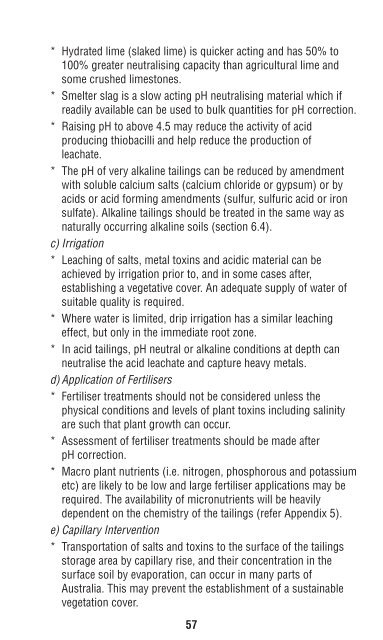Mine Rehabilitation Handbook - Mining and Blasting
Mine Rehabilitation Handbook - Mining and Blasting
Mine Rehabilitation Handbook - Mining and Blasting
Create successful ePaper yourself
Turn your PDF publications into a flip-book with our unique Google optimized e-Paper software.
* Hydrated lime (slaked lime) is quicker acting <strong>and</strong> has 50% to<br />
100% greater neutralising capacity than agricultural lime <strong>and</strong><br />
some crushed limestones.<br />
* Smelter slag is a slow acting pH neutralising material which if<br />
readily available can be used to bulk quantities for pH correction.<br />
* Raising pH to above 4.5 may reduce the activity of acid<br />
producing thiobacilli <strong>and</strong> help reduce the production of<br />
leachate.<br />
* The pH of very alkaline tailings can be reduced by amendment<br />
with soluble calcium salts (calcium chloride or gypsum) or by<br />
acids or acid forming amendments (sulfur, sulfuric acid or iron<br />
sulfate). Alkaline tailings should be treated in the same way as<br />
naturally occurring alkaline soils (section 6.4).<br />
c) Irrigation<br />
* Leaching of salts, metal toxins <strong>and</strong> acidic material can be<br />
achieved by irrigation prior to, <strong>and</strong> in some cases after,<br />
establishing a vegetative cover. An adequate supply of water of<br />
suitable quality is required.<br />
* Where water is limited, drip irrigation has a similar leaching<br />
effect, but only in the immediate root zone.<br />
* In acid tailings, pH neutral or alkaline conditions at depth can<br />
neutralise the acid leachate <strong>and</strong> capture heavy metals.<br />
d) Application of Fertilisers<br />
* Fertiliser treatments should not be considered unless the<br />
physical conditions <strong>and</strong> levels of plant toxins including salinity<br />
are such that plant growth can occur.<br />
* Assessment of fertiliser treatments should be made after<br />
pH correction.<br />
* Macro plant nutrients (i.e. nitrogen, phosphorous <strong>and</strong> potassium<br />
etc) are likely to be low <strong>and</strong> large fertiliser applications may be<br />
required. The availability of micronutrients will be heavily<br />
dependent on the chemistry of the tailings (refer Appendix 5).<br />
e) Capillary Intervention<br />
* Transportation of salts <strong>and</strong> toxins to the surface of the tailings<br />
storage area by capillary rise, <strong>and</strong> their concentration in the<br />
surface soil by evaporation, can occur in many parts of<br />
Australia. This may prevent the establishment of a sustainable<br />
vegetation cover.<br />
57<br />
* A layer of crushed waste rock over the tailings prior to the<br />
placement of topsoil can reduce or eliminate this effect. Crush<br />
rock to minus 10-20mm diameter <strong>and</strong> make the capillary<br />
intervention layer at least 300mm thick.<br />
f) Surface Manipulation<br />
* In arid areas, the surface of a tailings storage area may crust in<br />
a similar way to salt pans. Ridge ploughing or the creation of<br />
pond areas causes removal of salts from the root zone (section<br />
6.4.2).<br />
g) Protection from S<strong>and</strong>-blast<br />
* Physical damage to vegetation by s<strong>and</strong>-blast can be a major<br />
limiting factor for vegetation establishment.<br />
* Irrigation, rock cladding etc may reduce or prevent s<strong>and</strong>blast,<br />
but where direct revegetation of tailings material is being<br />
attempted, wind-breaks may be required. (section 5.3.1).<br />
h) Use of Topsoil<br />
* Covering tailings with a layer of topsoil is often the most<br />
effective method of establishing a vegetation cover. This is most<br />
effective after a layer of material has been used to limit capillary<br />
rise (see (e) above).<br />
* Even a thin layer of topsoil can introduce essential micro-flora<br />
into the growing medium.<br />
6.3 Acid Drainage<br />
Acid drainage (formerly referred to as AMD or ARD) is the term used to<br />
describe leachate that has become acid due to the oxidation of sulfur<br />
minerals exposed to air <strong>and</strong> water. Acid drainage may be recognised by<br />
orange/yellow ferric hydroxide precipitate in streambeds <strong>and</strong>/or a<br />
sulfurous smell, but this does not always occur. Acid soils may be an<br />
indication of a potential acid drainage problem.<br />
The most effective <strong>and</strong> economical method of controlling acid drainage<br />
is to prevent its formation. Once established, acid drainage is often<br />
difficult <strong>and</strong> costly to treat. Because most metal ions are increasingly<br />
soluble with decreasing pH, acid drainage frequently results in a heavy<br />
metals problem. Management by prevention requires characterisation of<br />
overburden or waste material <strong>and</strong> knowledge of the hydrology of the site<br />
so that the likely occurrence of acid drainage can be predicted <strong>and</strong><br />
potentially acid-producing material selectively h<strong>and</strong>led <strong>and</strong> isolated.<br />
58
















